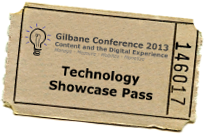In another installment of Speaker Spotlight, we posed a couple of our frequently asked questions to speaker Pawan Deshpande, Founder and CEO of Curata. We’ve included his answers here. Be sure to see additional Speaker Spotlights from our upcoming conference.
Speaker Spotlight: Pawan Deshpande
Founder and CEO
Curata
Is there a “Marketing Technologist” role in your organization or in organizations you know of? Should there be? What should their responsibilities be?
There is no doubt that marketing technology is here to stay. Some analyst firms have even predicted that marketing’s technology budget will one day outpace that of the IT department. (i.e., Forrester) In order to manage the increased adoption and leverage of technology across the marketing organization, as well as integration with other functions, CMOs will need to put in place a marketing technologist role. Two questions may come to mind when reading this recommendation:
- Isn’t that the role of marketing operations?; and
- Isn’t that the role of the IT department?
The marketing operations (MO) role first developed approximately 8-10 years ago, as covered by IDC’s CMO Advisory Service, (i.e., Rise of the Marketing Operations Function). The MO role was developed in response to the need for a process-oriented marketer who would be able to apply greater rigor to marketing’s investment management, demand generation process, performance measurement process, and overall technology. Although this role proved highly valuable in the short-term for change management, the rapid growth of marketing technology and the need for greater marketing accountability proved too much to bear for one function. More importantly, each marketing area needed to have its own level of expertise and rigor in process and technology.
Some marketing organizations attempted to increase their dependence on the IT department. However, this strategy proved detrimental since marketing technology was rarely a priority for IT teams, and IT lacks the in depth understanding of the marketing process. Better organizations tapped into the power of SaaS solutions to bypass IT, however, this still left a very disjointed marketing technology strategy. Enter the marketing technologist.
Marketing technology touches every part of marketing’s “supply chain”; from awareness building (e.g., social media, content marketing) to demand generation (e.g., lead processing, lead nurturing) to sales enablement (e.g., content management and delivery to sales and partners). Having a marketing technologist in larger organizations provides the opportunity to develop and deploy a more connected marketing strategy across the organization. This individual/team will be responsible for managing the technology associated with the different elements of marketing, as well as collaborating with the following teams: marketing-dedicated folks within IT, sales operations, and finance. (i.e., at global, regional and business unit levels). Specific examples where this role could add value include:
- Developing a marketing technology roadmap across all functional areas (current, 1 year and 3 year plan);
- Continuing to refine the demand management process (e.g., integration of marketing automation with sales’ pipeline process/technology); and
- Taking on the new challenge of supporting content marketing from a technology perspective. (e.g., content creation, content curation, content lifecycle management).
What is the best overall strategy for delivering content to web, multiple mobile, and upcoming digital channels? What is the biggest challenge? Development and maintenance cost? Content control? Brand management? Technology expertise?
If you ask any large company CMO about their content inventory, they will quickly tell you that they have too much content. A conversation with the same company’s digital marketing team (i.e., the team that delivers content to blogs, microsites, newsletters, web sites and social media channels) will reveal that they don’t have enough content. Herein lies the greatest challenge for delivering digital content: Putting the process and technology in place for disparate parts of an organization to collaborate on developing relevant and high quality for their audience; and getting this content to them in the right time, place, and format to drive greater engagement. Addressing this challenge will require the development of two new roles in marketing: a senior level marketing strategist to develop and deploy a content management process (e.g., VP Content Strategy) and a marketing technologist.
Catch Up with Pawan at Gilbane
Track C: Content, Marketing, and the Customer Experience
C10: Content Strategies: Customer Experience, Competition, Content Marketing and Curation
Wednesday, December 4: 2:00 p.m. – 3:20 p.m.
Find out more about this session and our other conference sessions here.
Be sure to follow Pawan @TweetsFromPawan
[button link=”http://gilbaneconference.com/program” variation=”red”]Complete Program[/button] [button link=”http://gilbaneconference.com/schedule” variation=”red”]Conference Schedule[/button] [button link=”http://gilbaneconference.com/registration” variation=”red”]Register Today[/button]













